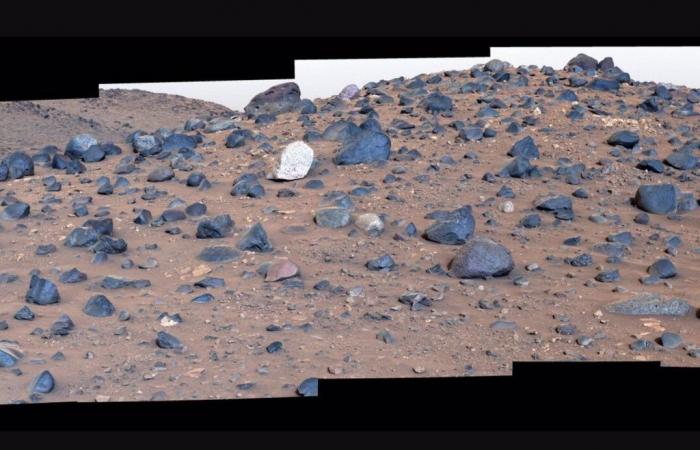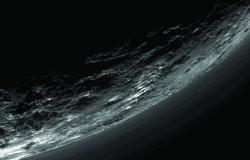On May 17, Perseverance captured this mosaic looking downstream from the dune-filled Neretva Vallis Riverbed. The canal fed Jezero Crater with fresh water billions of years ago. – NASA/JPL-CALTECH/ASU/MSSS
MADRID, June 14 (EUROPA PRESS) –
A change of route taken by Perseverance, crossing an ancient river on Mars, has led the NASA rover to find a unique rock on a hill, placed there by magma or water.
Perseverance is located in the final stages of its fourth scientific campaign, in which he searches for evidence of carbonate and olivine deposits in ‘Margin Unity’, an area along the interior of the Jezero Crater rim.
Located at the base of the canal’s northern wall, the immediate ‘Bright Angel’ destination area features light-toned rock outcrops which may represent ancient rocks exposed by river erosion or sediments that filled the channel. The team hopes to find rocks other than those in the carbonate- and olivine-rich ‘Margin Unity’ and gather more clues about Jezero’s history.
To reach ‘Bright Angel’, the rover traveled along a ridge along the Neretva Vallis river channel, which billions of years ago carried a large amount of water that flowed into the Jezero Crater. “We started sailing parallel to the channel at the end of January and were making good progress, but then the rocks became bigger and more numerous,” he said it’s a statement Evan Graser, deputy director of strategic route planning for Perseverance at NASA’s Jet Propulsion Laboratory. “What had been traveled with an average of more than one hundred meters per Martian day was reduced to only a few tens of meters. “It was frustrating.”
In rugged terrain, Evan and his team use images from the rover to plan courses of approximately 30 meters. To go further on a given Martian day or sol, planners rely on Perseverance’s automatic navigation system, or AutoNav, to take control. But as the rocks became more abundant, AutoNav, more often than not, determined that the going was not to its liking and stopped, diminishing the prospects of a timely arrival at ‘Bright Angel.’ However, the team was hopeful, knowing that they could succeed by cross a 400 meter dune field in the river channel.
“We had been watching the river channel just to the north as we went, hoping to find a section where the dunes were small and far enough apart for a rover to pass between them, because dunes are known to eat people.” Mars rover,” Graser said. “Perseverance also needed an on-ramp that we could travel on safely. “When the images showed both, we headed straight for her.”
The Perseverance science team was also eager to travel through the ancient river channel because they wanted to investigate ancient Martian river processes.
With AutoNav helping guide the way at the bottom of the channel, Perseverance covered the 200 meters to the first scientific stop on a Martian day. The target: “Mount Washburn,” a hill covered in intriguing rocks, some of a type never before observed on Mars.
“The diversity of textures and compositions at Mount Washburn was an exciting discovery for the team, as these rocks represent a grab bag of geological gifts brought from the crater rim and potentially beyond,” said Brad Garczynski of Western University. Washington in Bellingham, the co-director of the current scientific campaign. “But among all these different rocks, there was one that really caught our attention“. They nicknamed it ‘Atoko Point’.
A LIGHT ROCK AMONG MANY DARK ROCKS
About 45 centimeters wide and 35 centimeters high, the light-toned speckled rock stands out in a field of darker rocks. Analysis of Perseverance’s SuperCam and Mastcam-Z instruments indicates that The rock is composed of the minerals pyroxene and feldspar. In terms of the size, shape and arrangement of its mineral grains and crystals (and potentially its chemical composition), Atoko Point is unique.
Some Perseverance scientists speculate that the minerals that make up ‘Atoko Point’ They were produced in an underground magma body which is possibly now exposed on the crater rim. Other team members wonder if the rock was created far beyond the walls of Jezero and transported there by the fast Martian waters eons ago. Either way, the team believes that while Atoko is the first of its kind they’ve seen, It won’t be the last.
After leaving Mount Washburn, the rover headed 132 meters north to investigate the geology of ‘Tuff Cliff’ before making the four-sol, 605-metre journey to ‘Bright Angel’. Perseverance is currently analyzing a rock outcrop to evaluate whether a rock core sample should be collected.






